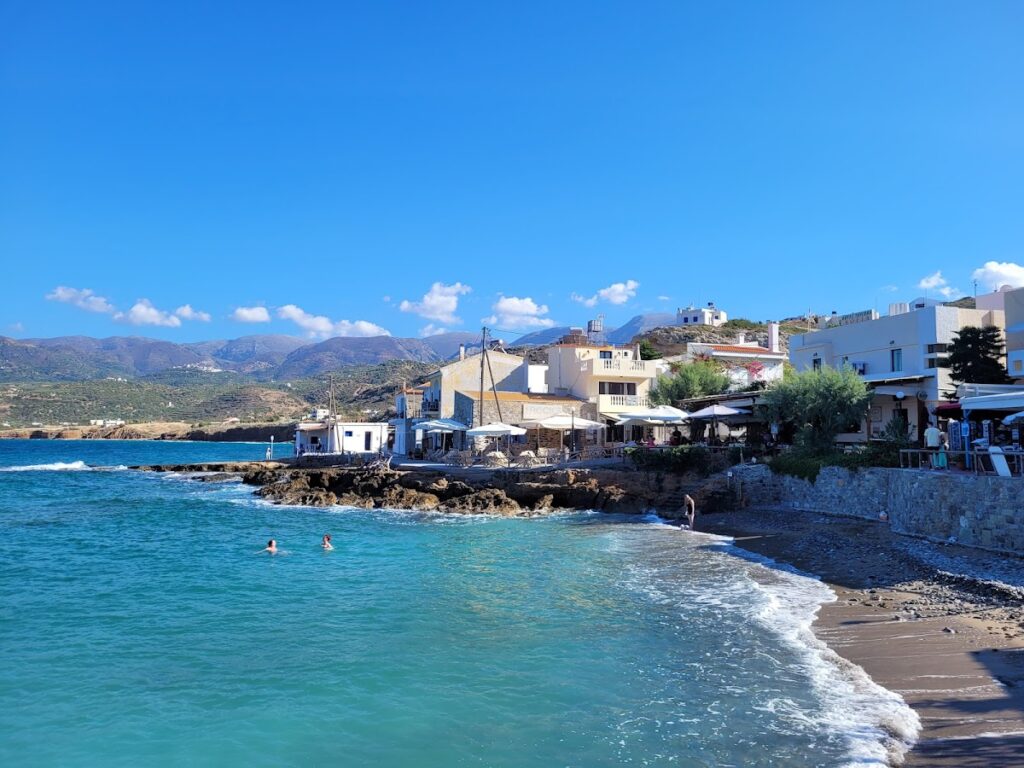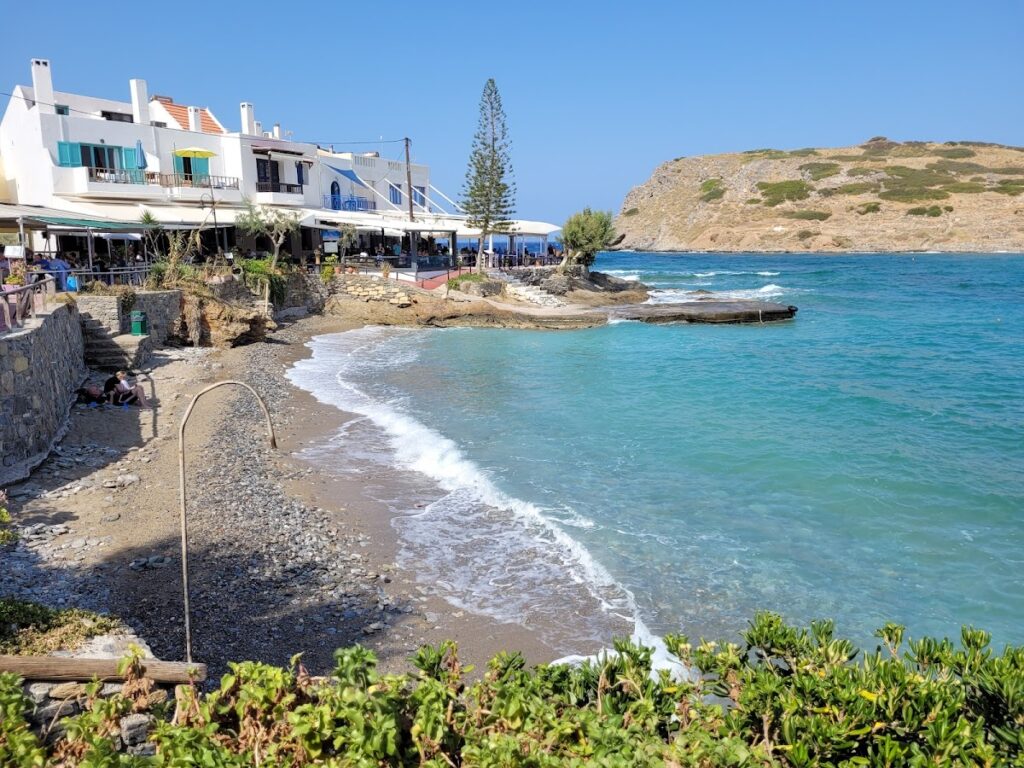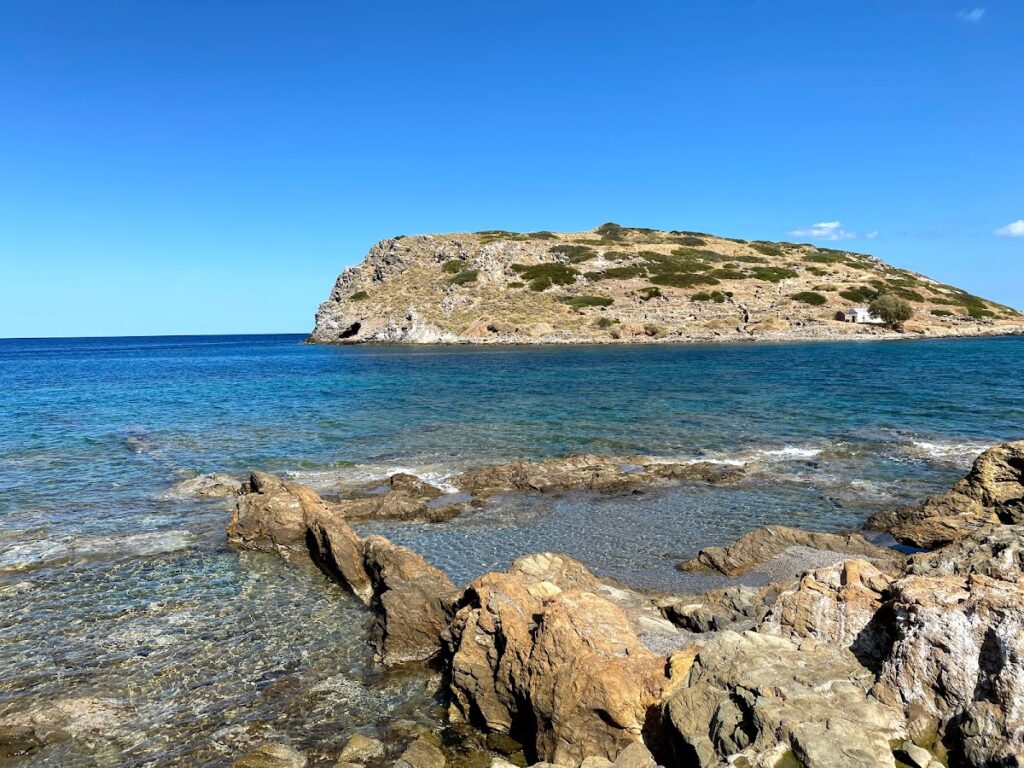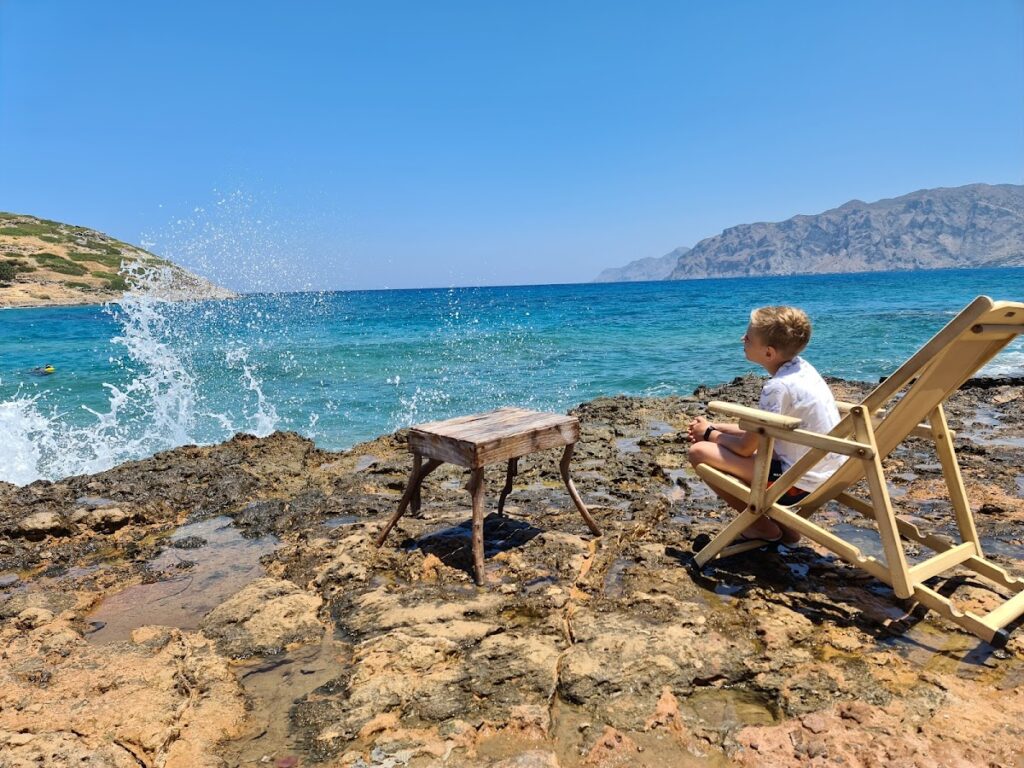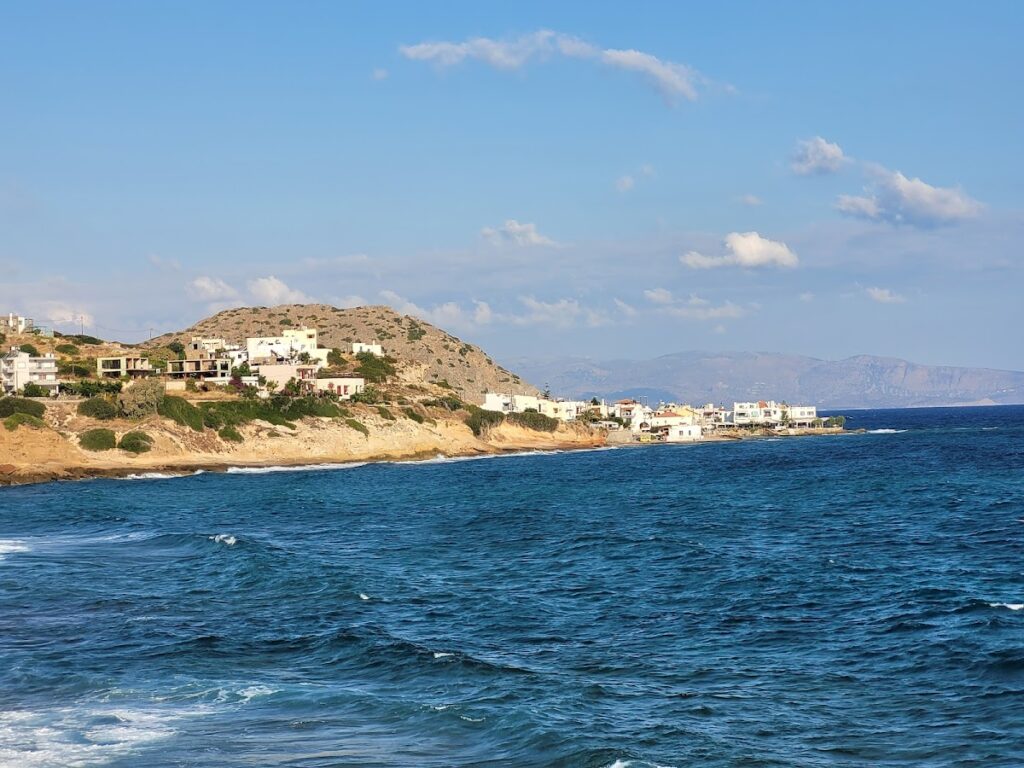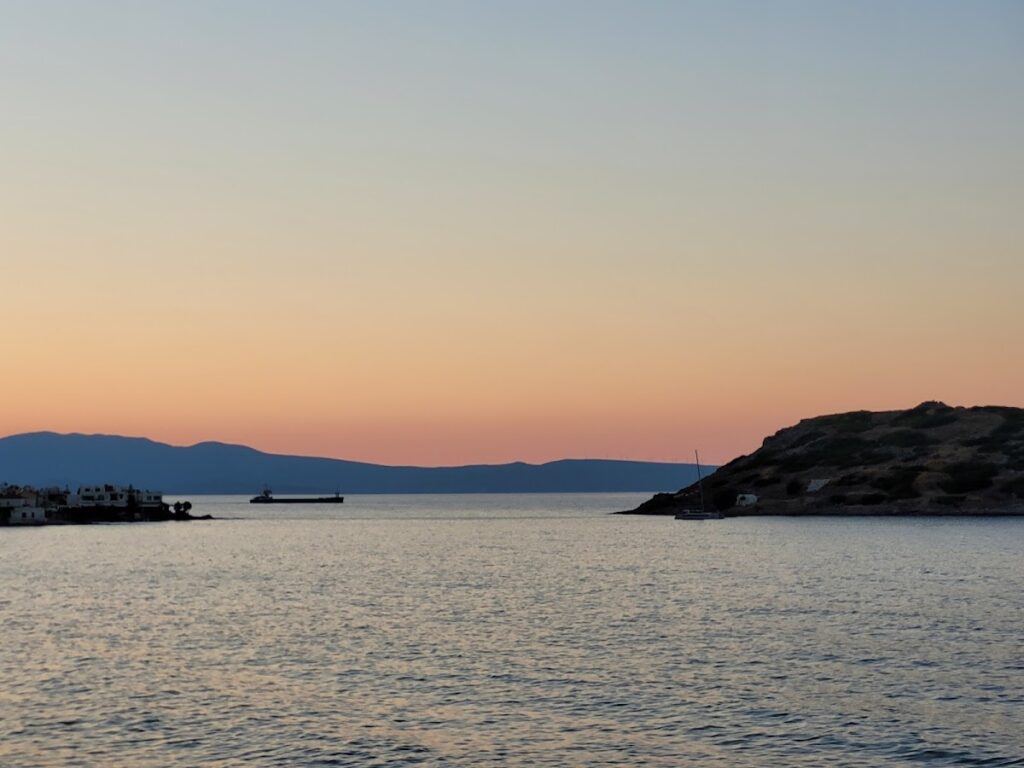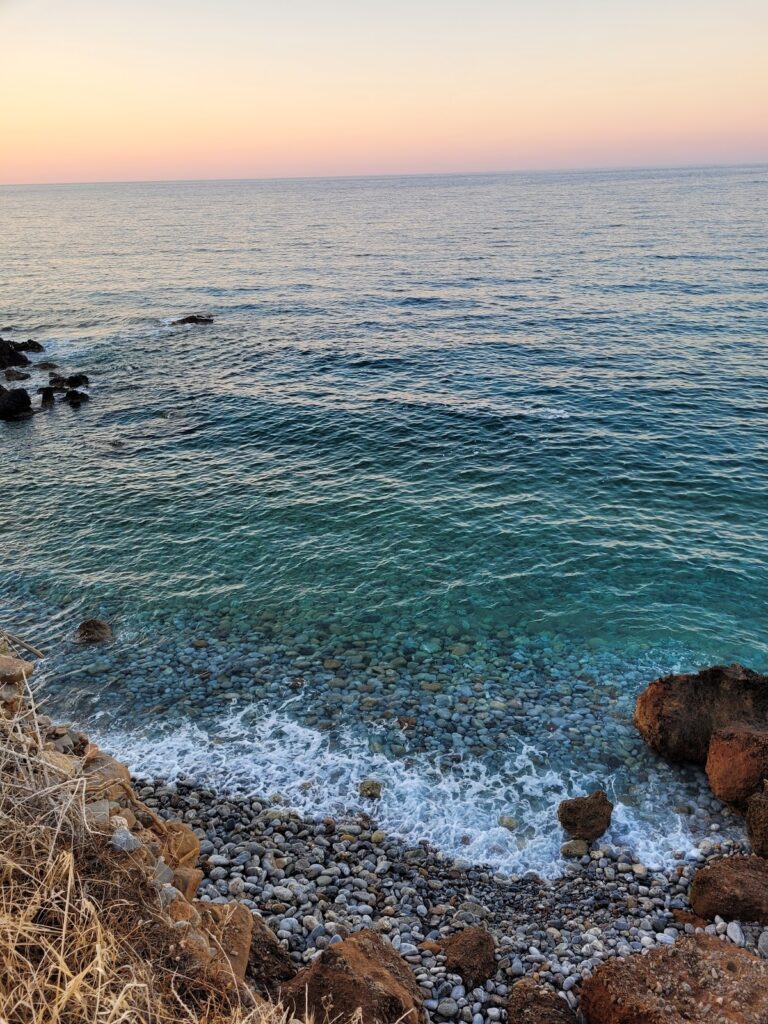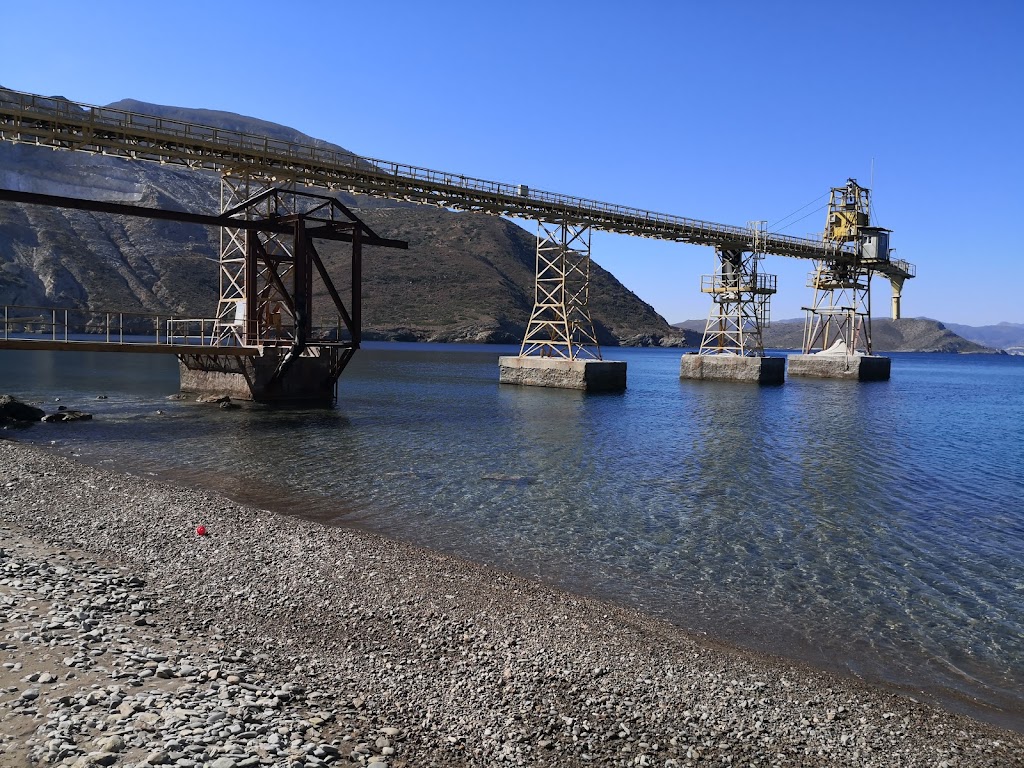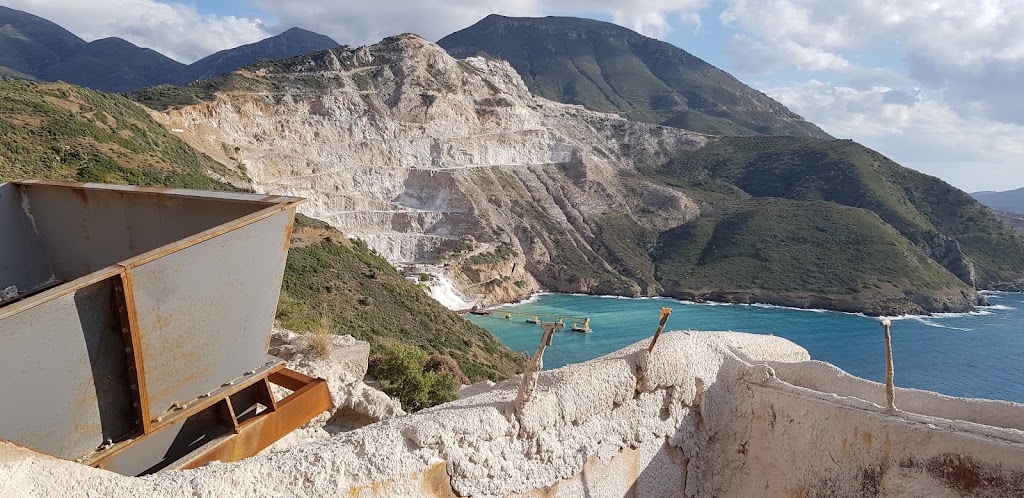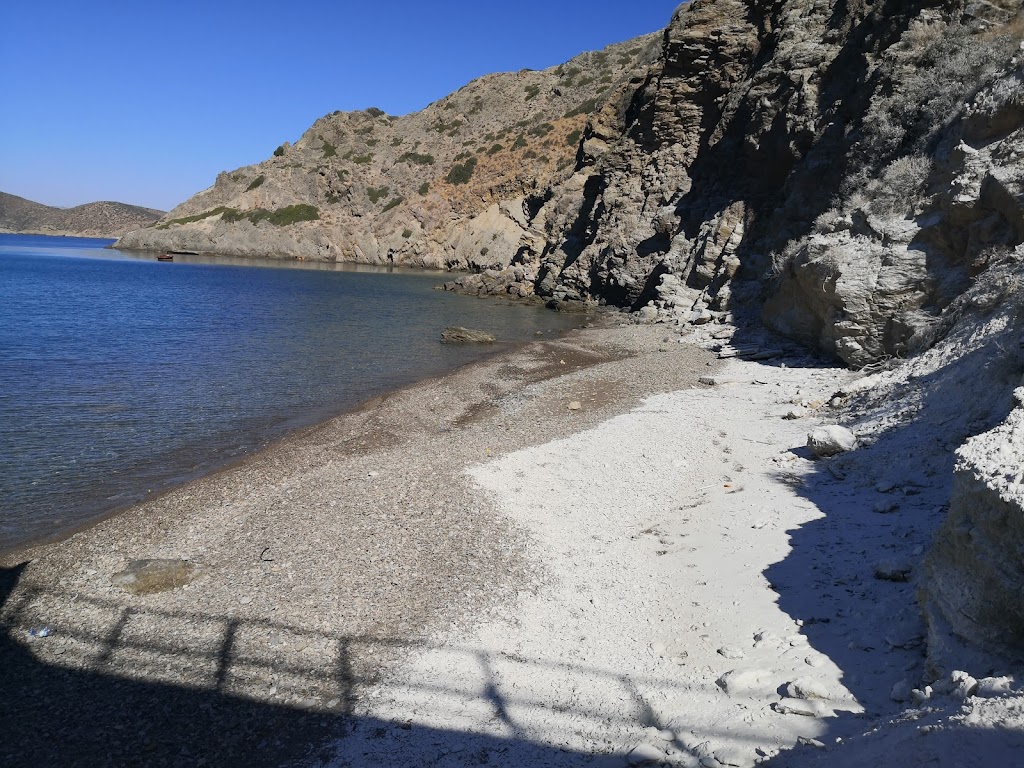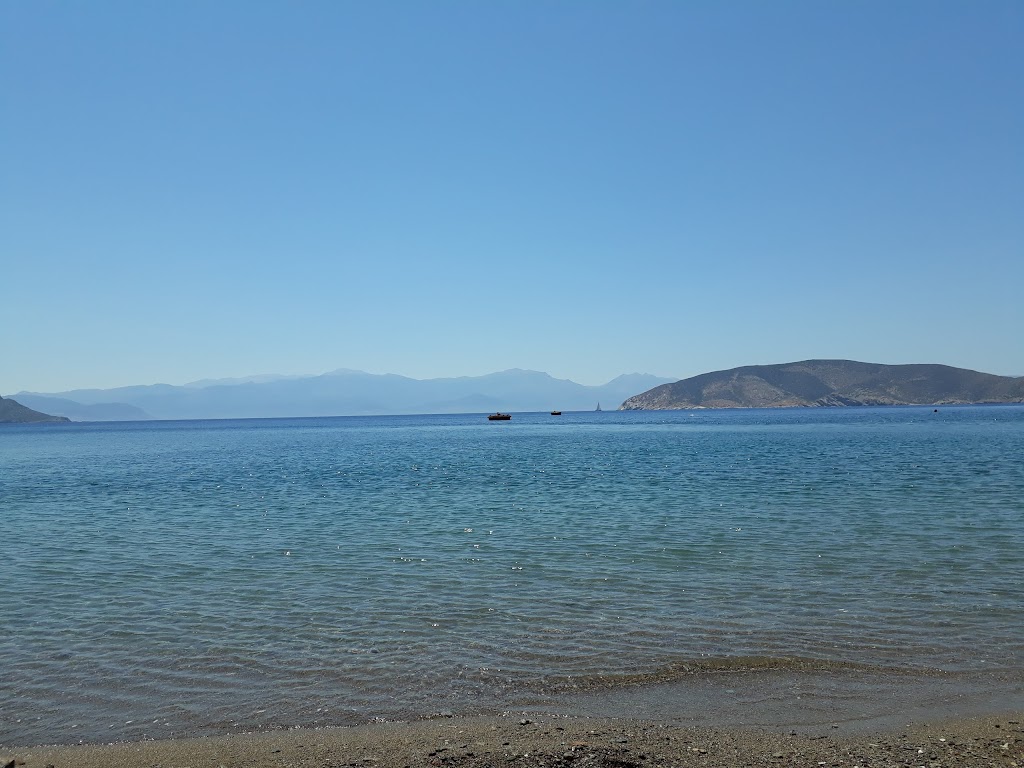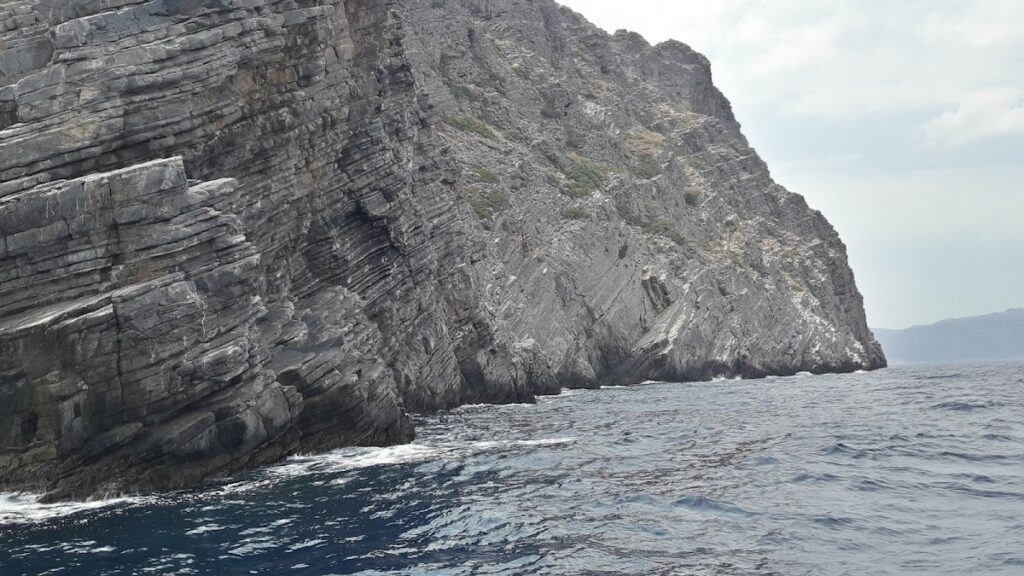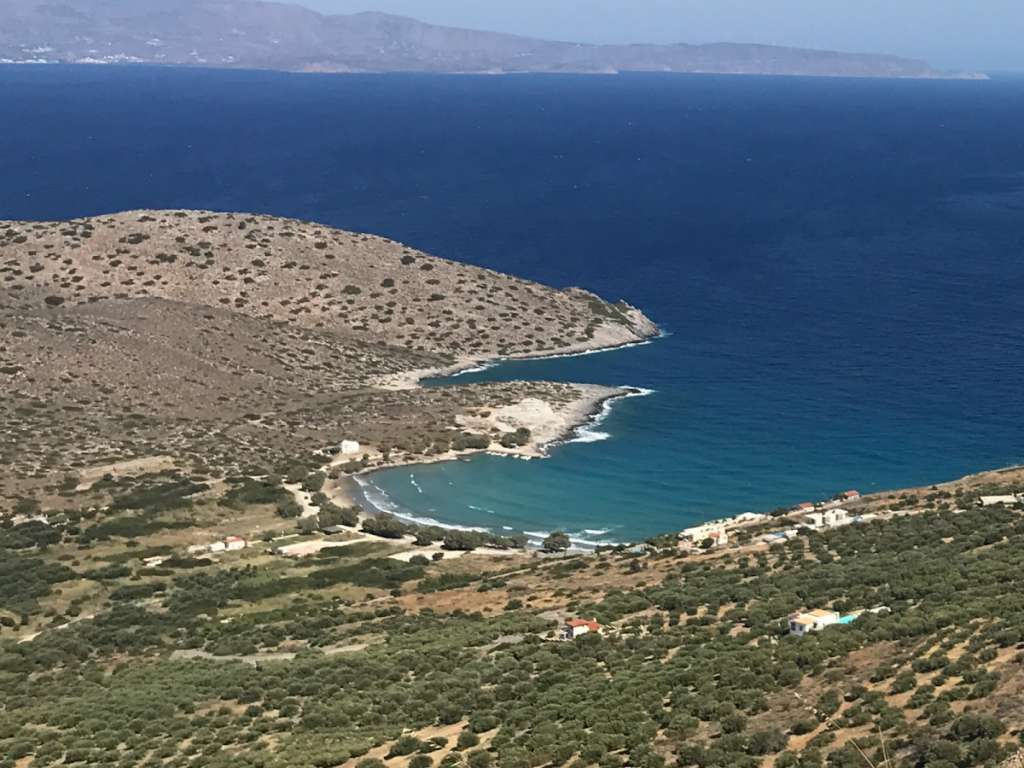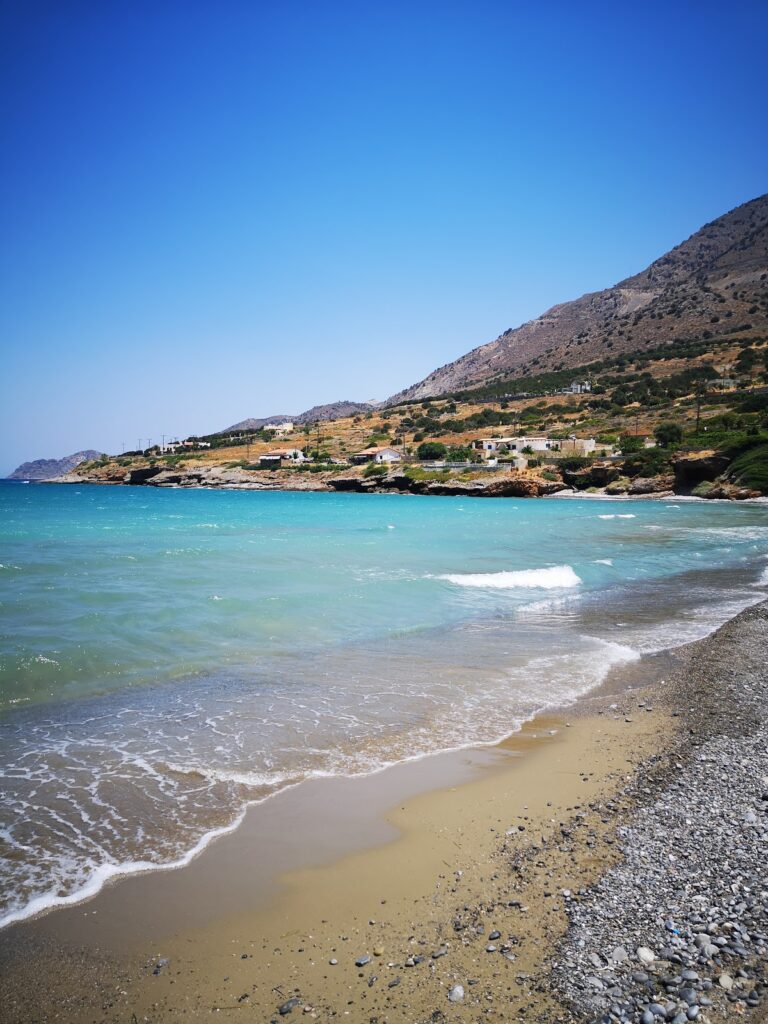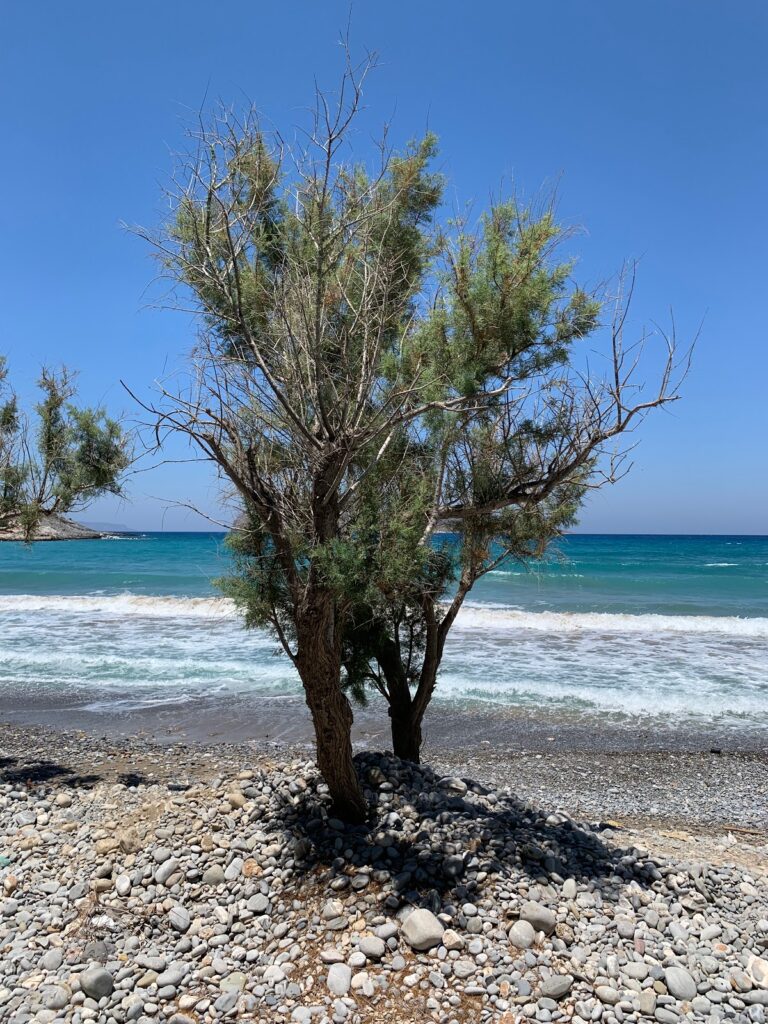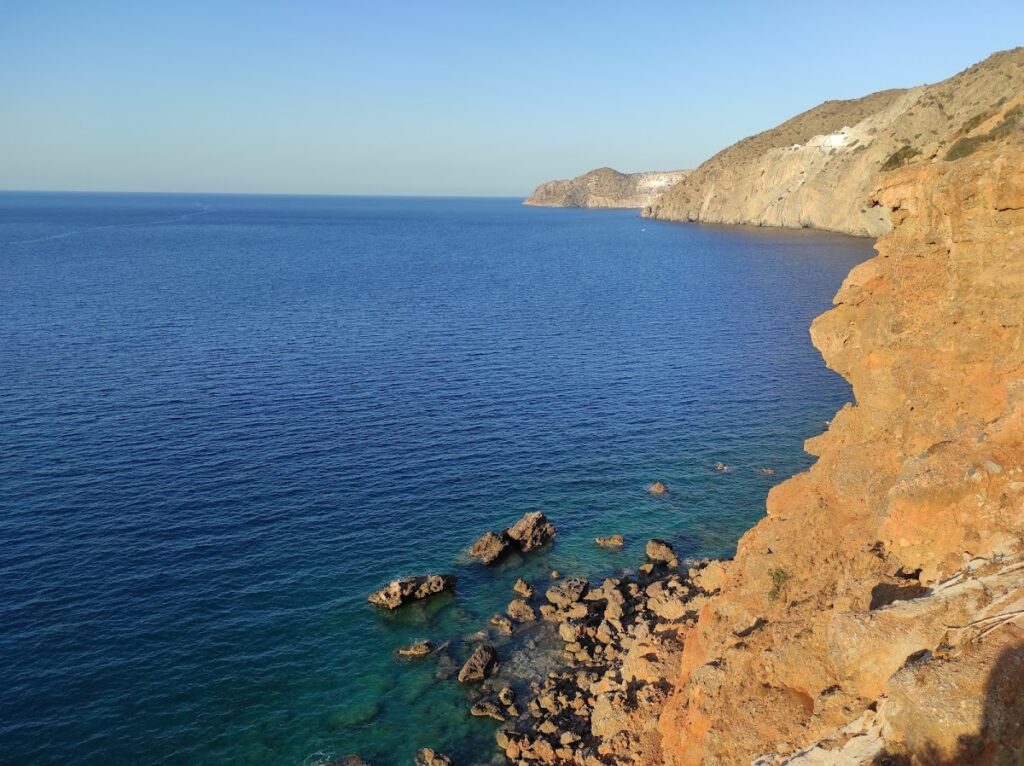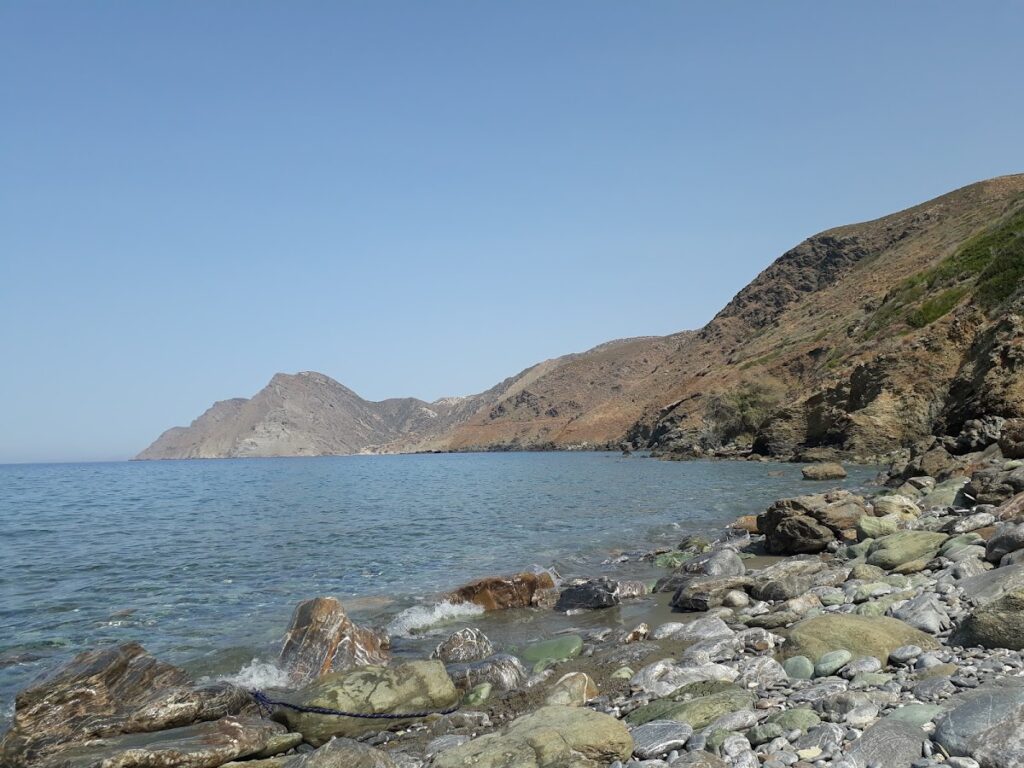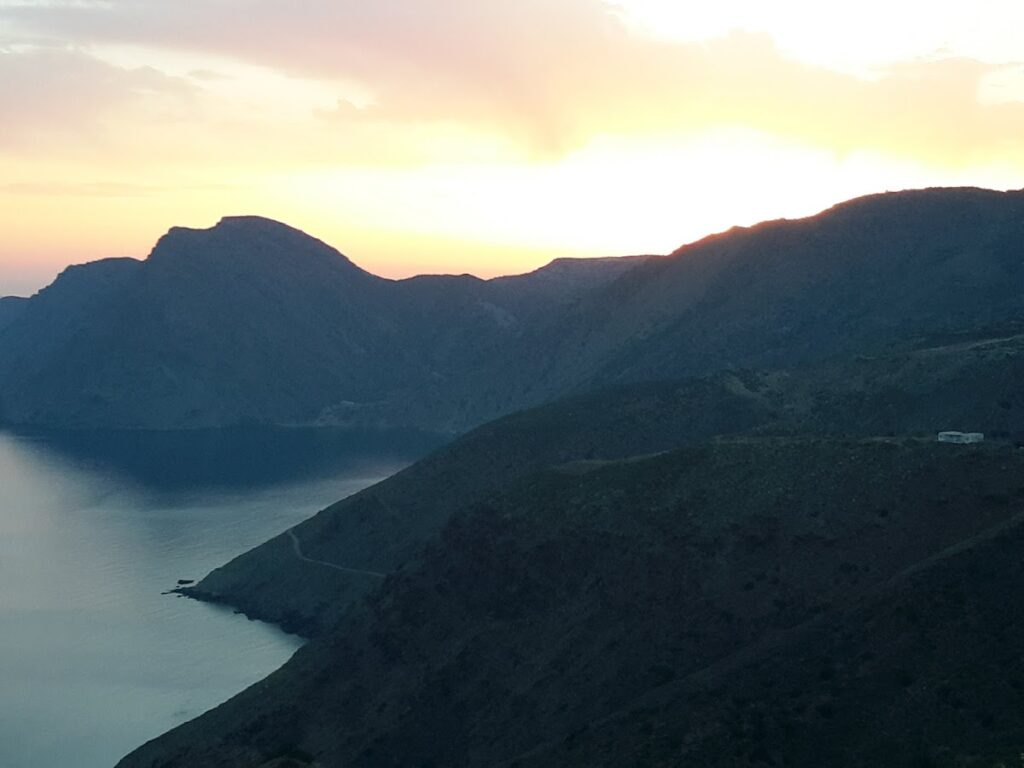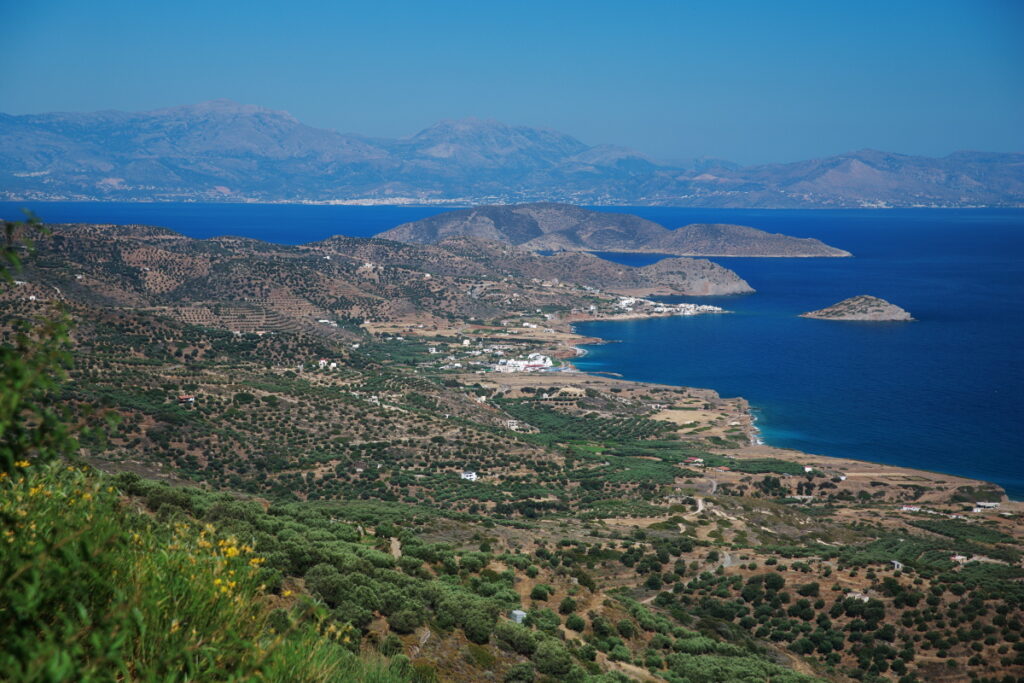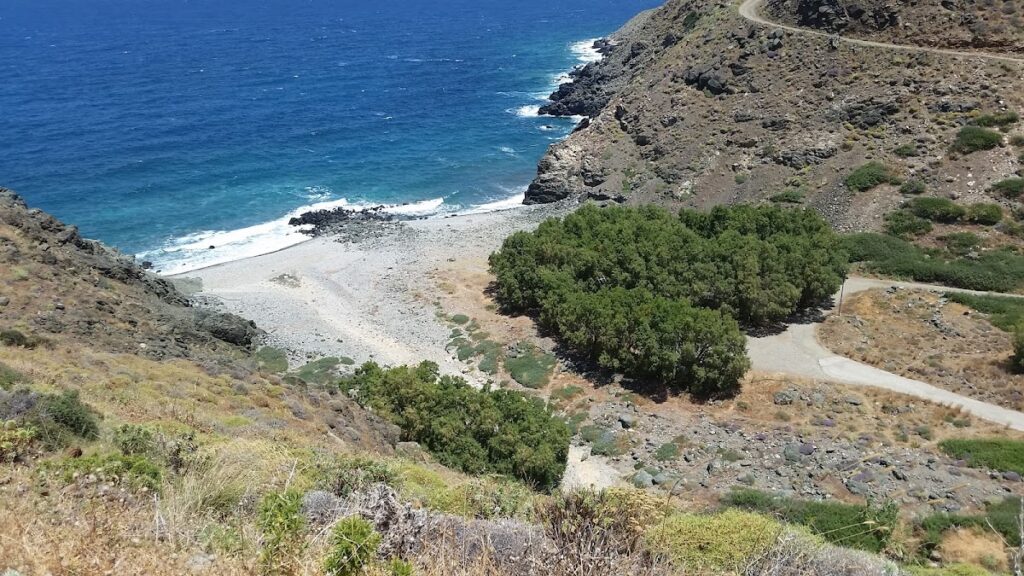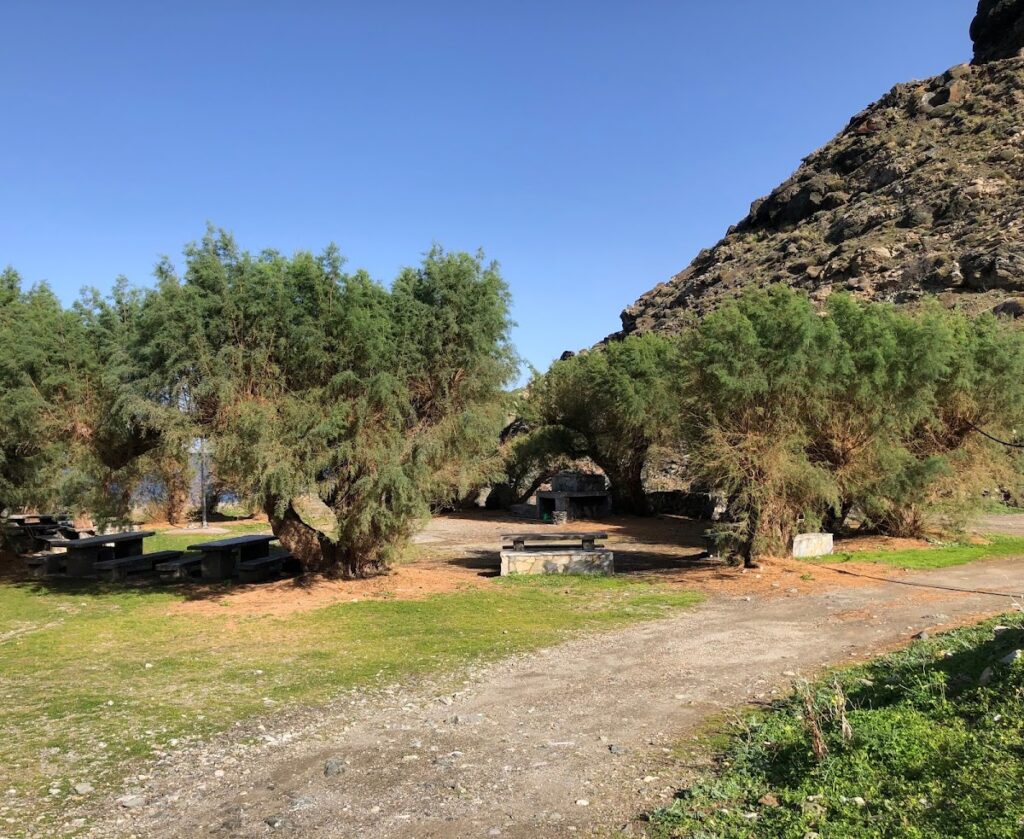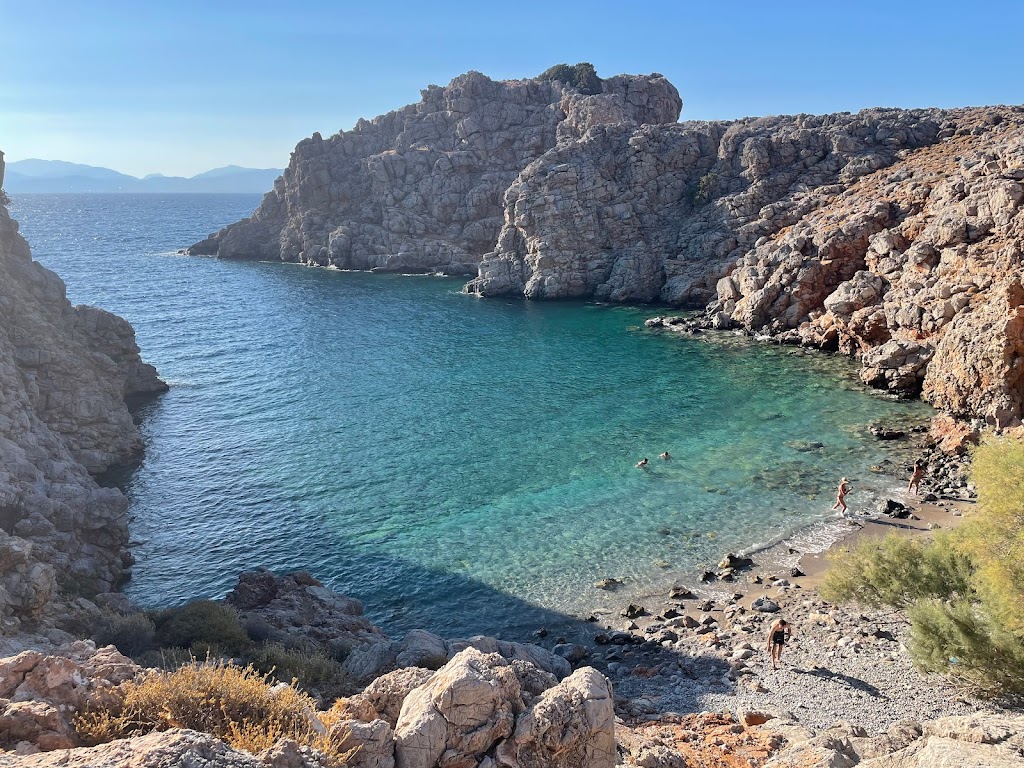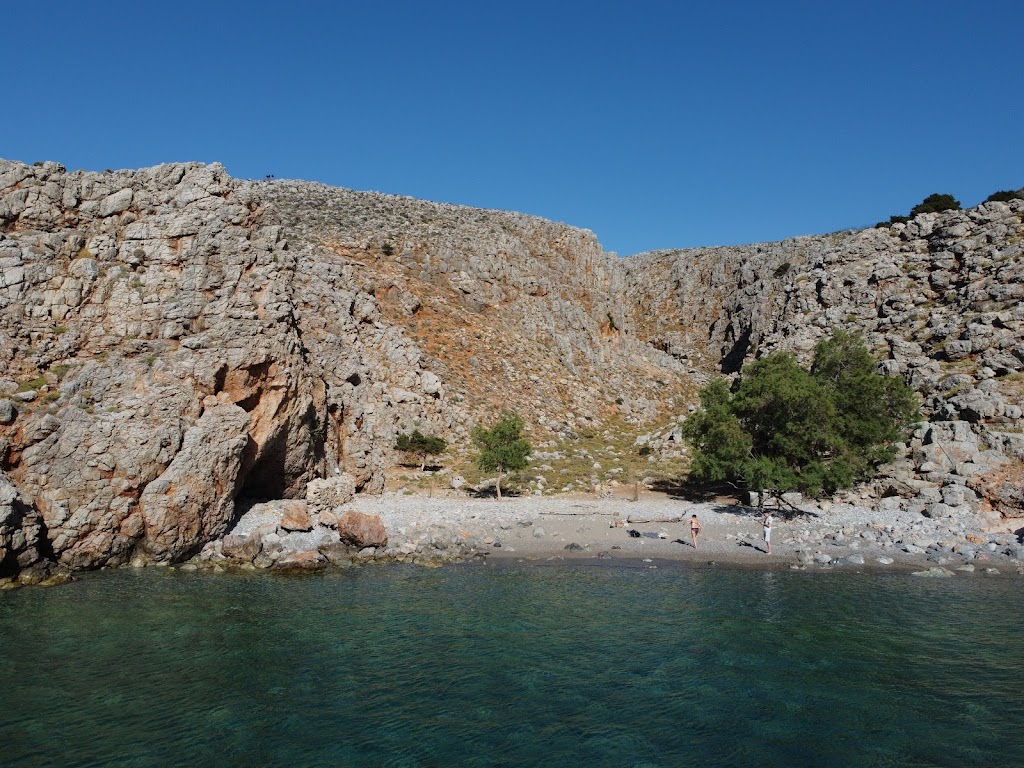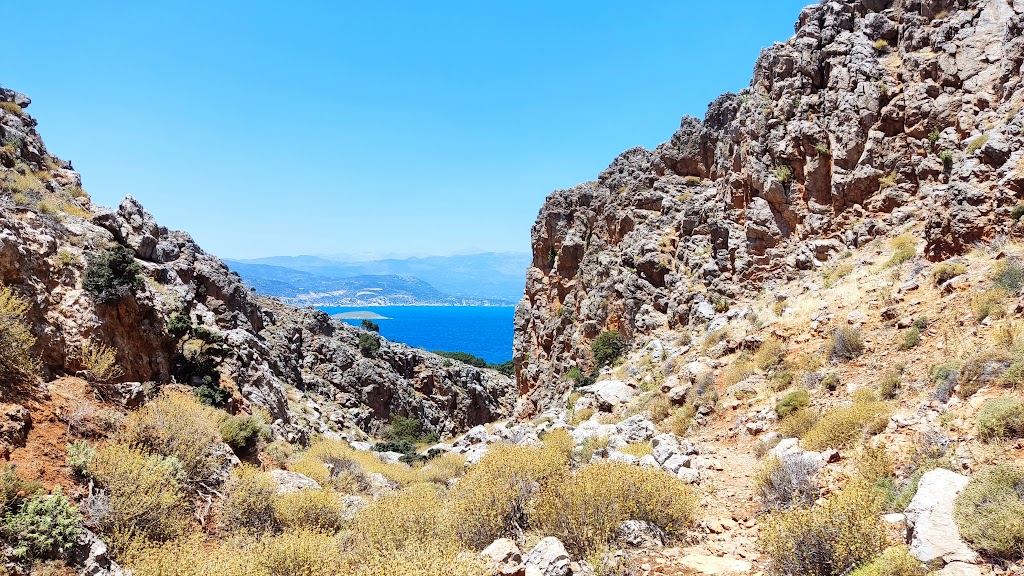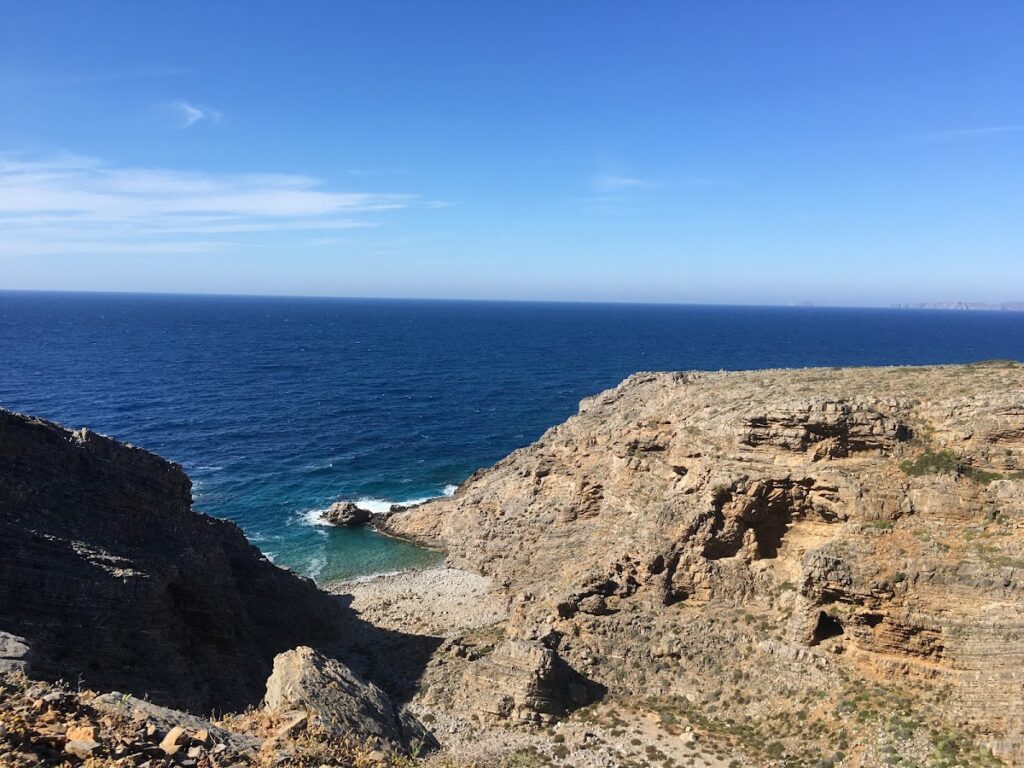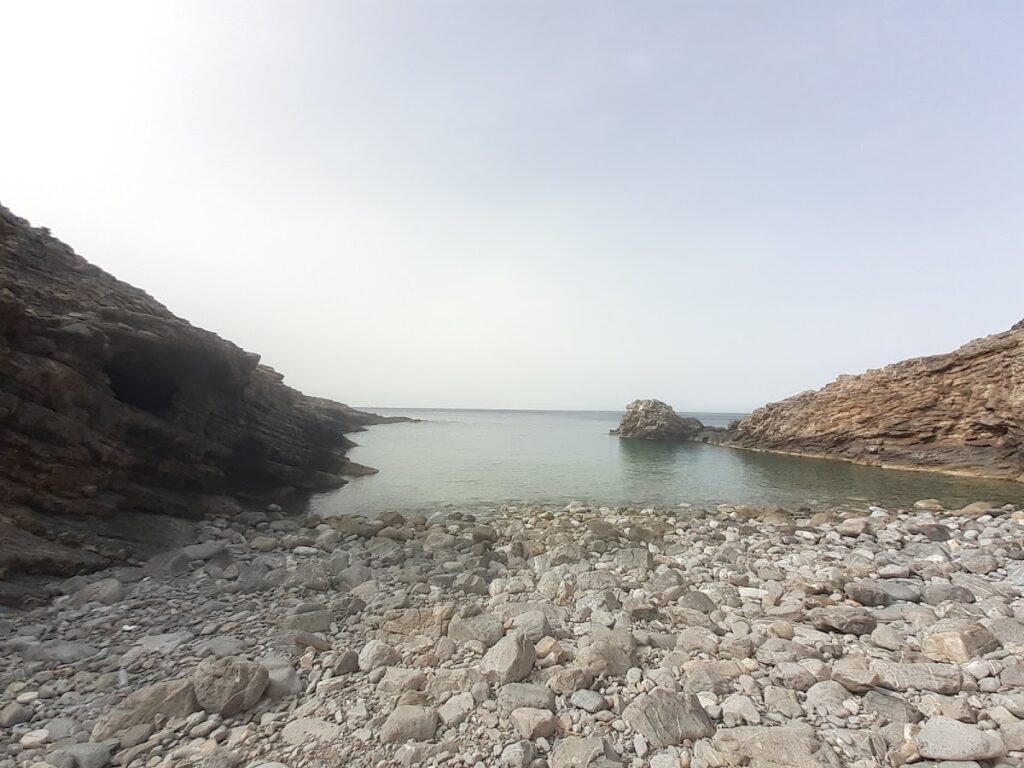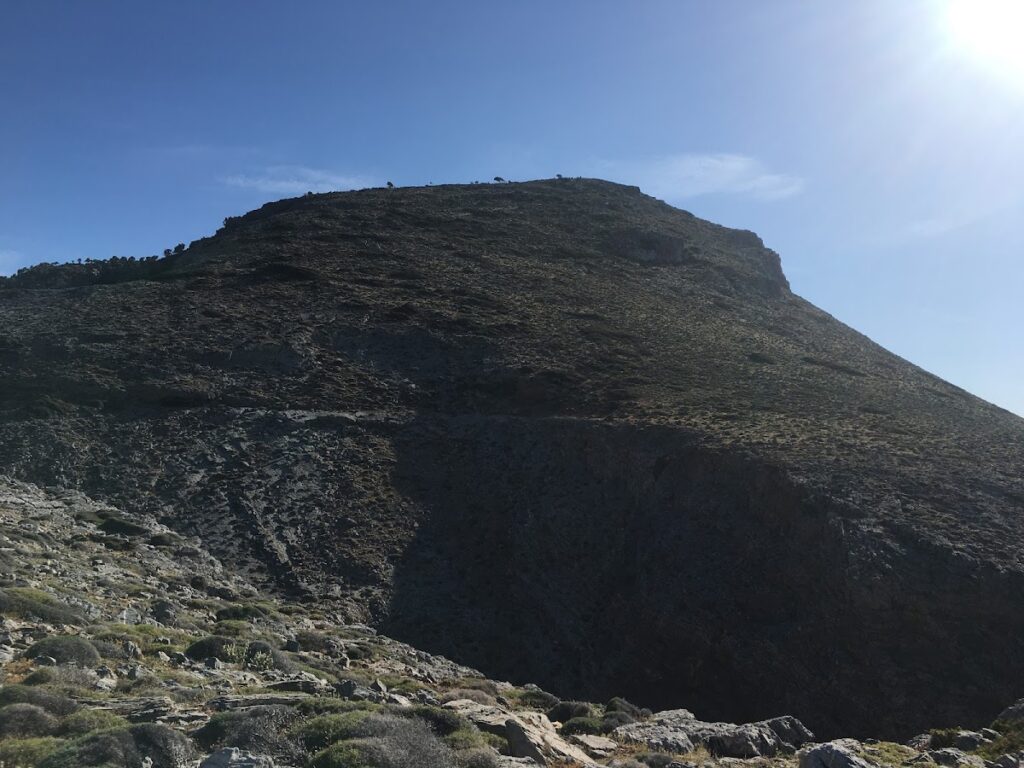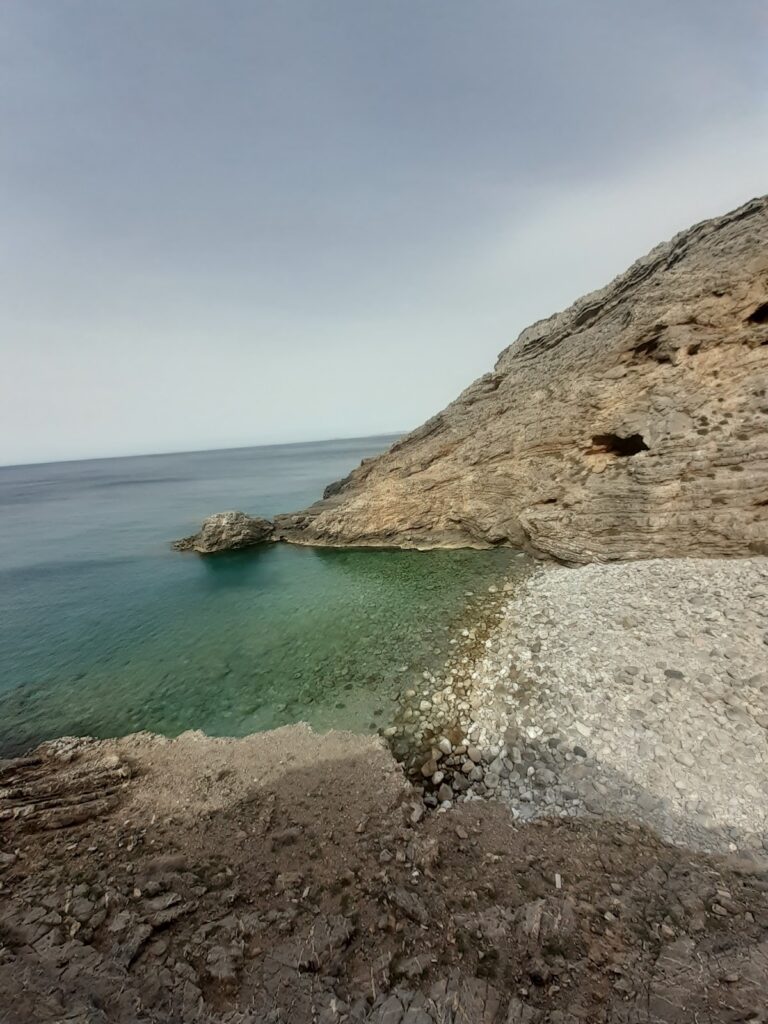Beaches near Móchlos, in Lassithi region
Here is list of closest beaches to Móchlos
- 100 m
- Mochlos beaches
- Rocks in places, Sand
- Normal
- Blue
Mochlos is a quaint village situated 48km to the east of Agios Nikolaos and 35km to the west of Sitia. It lies 150m across from the islet of St. Nicholas, home to a chapel of the same name and an important archaeological site. The village of Mochlos maintains its traditional Cretan charm, making it an ideal destination for a peaceful getaway. The friendly locals, primarily from the village of Sfaka, will make you feel at home from day one. You may even get the chance to participate in local events such as fishing competitions.
The village’s coastal road is dotted with a handful of taverns and cafes where you can savour fresh seafood and refreshing drinks. These establishments have even gained popularity among notable Greeks. An old tax office previously stood next to these taverns but was unfortunately torn down several years ago. The small sandy beach of Mochlos, with its rocky seabed, lies in front of the village. It offers basic facilities but is not officially organized. A second, smaller and rockier bay can be found to the east of the village.
For those seeking solitude, the sandy beach of Limenaria lies 400m west of Mochlos. This beach and the local harbour are well shielded from the waves. In 1986, archaeologists discovered a post-Minoan cemetery with several intact carved tombs in Limenaria. Over 60 decorated vases and a Minoan seal featuring a deer were found at this site.
When visiting Mochlos, it’s worth exploring the neighbouring villages of Sfaka, Lastros, Tourloti, and Myrsini. These villages have preserved their traditional character and house some very old chapels. Furthermore, south of Mochlos, atop a hill, you can visit the scenic chapel of Holy Spirit (Agio Pnevma in Greek), which offers panoramic views of the Mirabello Gulf. Lastly, near the village of Myrsini, you will find the Venetian Tower of Kornaros and the chapel of St. Anthony.
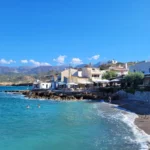
- 1.5 km
- Loutres beaches
- Pebbles, Rocks in places, Sand
- Deep
- Blue
Situated 48km east of Agios Nikolaos and 35km west of Sitia is the quaint village of Mochlos. A short 300m journey eastward, near the Agios Andreas settlement, reveals several secluded bays filled with rounded pebbles. Known by the locals as Kolimbakia or Loutres coves, these spots are perfect for snorkelling and fishing, thanks to the rocky seafloor that houses a multitude of fish. Beyond the coves, you’ll find the well-equipped Stomio beach, fronting a local hotel. It provides amenities such as umbrellas, showers, beach-volley courts, canoes, as well as sailing, windsurfing and diving facilities. Further east of Mochlos, the Mavro Selli beach awaits, characterized by a small stream and large pebbles.
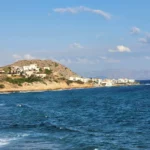
- 1.6 km
- Altsi bay
- Sand
- Deep
- Deep blue
Situated between Mochlos to the east and Malavra springs near Tholos to the west, you’ll find the gypsum quarries of Altsi, named after the Turkish term for plaster. This region is home to two hidden beaches, largely unvisited due to their proximity to the quarries. Access to these secluded Altsi beaches can be achieved through the road that guides you to the mills responsible for grinding the stones; this path is marked as a dead end just before reaching Mochlos. Despite the significant alteration of the scenery by the quarries, these beaches maintain their pristine condition and inherent beauty.
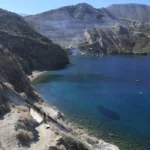
- 3.8 km
- Psira islet beaches
- Pebbles, Rocks in places, Sand
- Normal
- Blue
Psira, a small uninhabited island located opposite Kavousi, is renowned for being home to one of the most significant and affluent Minoan settlements discovered on Crete. However, it’s a lesser-known fact that Psira also boasts of remarkable natural beauty, featuring mysterious cliffs, sea caves, and enchanting beaches.
The island houses several petite beaches, with the largest one situated to the north of the settlement, featuring a sandy landscape. Right beneath the ancient settlement towards the south, a small bay hosts two exquisite pebble beaches. It’s noteworthy that all of Pseira’s beaches are on the island’s south side, thereby offering protection from the usual northern winds.
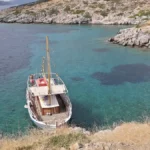
- 5.3 km
- Tholos beach
- Pebbles, Sand
- Normal
- Blue
Tholos, situated 26km to the east of Agios Nikolaos and 4km north of Kavoussi village, can also be referred to as Kavoussi beach. Nestled at the end of a fertile valley and framed by ancient olive groves and vineyards, the region has only seen minor touristic development, making it an ideal spot for a tranquil holiday. Tholos beach, with its combination of pebbly and sandy terrain on the west side and a small harbour, is surrounded by tamarisk trees that offer much-needed shade. Nearby, there are accommodations and taverns. The water at the beach, usually hazy and light blue, is the result of underwater springs from the Thripti mountain massif mixing with salt water.
Legameni Cape beaches
A stone’s throw away to the north of Tholos’ small harbour, two pebbly beaches have formed where two dry streams meet. These beaches, known as Legameni, owe their name to the local cape. It’s fascinating to observe aquatic plants growing out from the rocky sea bed, indicating the presence of fresh water underground. Both beaches provide stunning views of Malavra’s wild cliffs to the east of Tholos beach.
Malavra beach
If you travel 2km east from Tholos, you’ll discover the isolated beach of Malavra, encircled by towering cliffs. Accessible only by boat and typically impacted by northern winds, this beach until recently could be reached by foot from the nearby freshwater spring station at Malavra, via a dirt track from Tholos beach. However, a gate has now been installed to restrict access.
Surroundings and Sightseeing
Kavoussi, one of Crete’s lesser-known but intriguing regions, boasts a wealth of archaeological sites, natural wonders, and traditional villages. Directly opposite Tholos sits Psira Island, a significant Minoan harbour. You can visit Psira by boat from nearby Mochlos and explore its extensive Minoan settlement. The island’s most significant artefact, a carved mural, now resides in the Archaeological Museum of Heraklion.
To the west of Tholos, you’ll find the old frescoed chapel of St. Anthony. A stroll to Kavoussi will lead you to the village square, where you can explore the Venetian church of St. George, a beautiful example of Byzantine architecture, and the Temple of the Twelve Apostles at Ligaras.
The archaeological site of Azorias, just 2km east of Kavoussi, is home to one of the most awe-inspiring natural monuments on Crete – an olive tree over 3500 years old and the oldest surviving in the world. This tree, a protected monument, was used to crown the first winner of the Women’s Marathon at the 2004 Athens Olympic Games. A short 2km journey south of the monumental olive tree will take you to the canyons of Mesonas and Havgas, some of the wildest in East Crete.
In addition to these, it’s worth visiting the Minoan settlements at Vrondas and Kastro, the ancient copper workshop from the Minoan period at Chrysokamino, and the nearby cave of Theriospilios, known for its unique decor. East of Theriospilios, you’ll find the Minoan settlement of Chylopites.
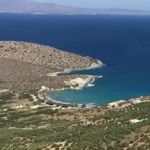
- 6.3 km
- Gela beach
- Pebbles, Sand
- Deep
- Deep blue
Gela (also known as Tigania) is nestled on the stony and shingle coast of northern Crete, largely shielded from westerly winds. It is situated approximately 58km east of Agios Nikolaos and 26km west of Sitia, nearby the village of Kalavros. To reach Gela from Agios Nikolaos, take the road to Sitia and follow the exit to Kalavros village. From there, follow the 5km dirt track that leads to the sea until you arrive at Gela’s shoreline. The location is incredibly secluded and features several tiny bays with pebble beaches and green-tinted waters, perfect for swimming on calm days. The bays are nestled near the steep, rocky coasts, and the sea here is deep.
The area is perfect for activities like fishing and snorkelling, as well as for those seeking solitude. You’re unlikely to encounter many others in this remote spot.
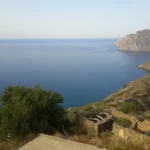
- 7.4 km
- Richtis beach
- Pebbles, Sand
- Deep
- Deep blue
Richtis beach (accessible through the Richtis Gorge) is nestled approximately 20km west of Sitia and 45km east of Agios Nikolaos. You can get to the beach via the paved road that starts from Exo Mouliana or opt for a scenic hike through the verdant gorge.
This petite, pebble-strewn cove boasts pristine waters, though its northern orientation often results in waves. The beach, with its round pebbles, may not be ideal for swimming, especially on windy days, but it promises absolute tranquility. Given the lack of nearby amenities, it’s advisable to bring your own food. The beach is dotted with tamarisk trees, encircled by stone seats and tables. You’ll also find a stone water fountain providing drinkable fresh water year-round.
A trip to Richtis beach often includes a trek through the stunning Richtis Gorge, named ‘Richti’ (the Cretan term for Waterfall) because of the 20m high waterfall within the gorge that creates an oasis in East Crete. The gorge is especially worth visiting in the spring.
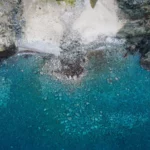
- 8.9 km
- Agriomandra beach
- Fine Pebbles, Pebbles
- Deep
- Deep blue, Green
Agriomandra, a hidden gem of a beach, can be found 24km east of Agios Nikolaos, or alternatively, 3km west of Kavousi village and Tholos beach. This beach, hidden at the exit of the Agriomandra gorge, is only accessible by foot through the canyon. To reach the entrance to the gorge, follow a dirt road that cuts through the verdant meadows west of Kavoussi, known as Lakos Ambelion. A short, manageable trail from this point will bring you to the beach, about a 10-minute walk. Along the way, you’ll notice several petite caves nestled into the rocks, one of which is a stone-built church from the Byzantine era, dedicated to St. John the Theologian. As you continue on, you’ll come upon the stunning pebbly beach with its transparent green waters, tucked away between the protective arms of the gorge cliffs.
The seclusion of the beach, primarily due to its challenging access, makes it the perfect spot for privacy, nudism, and snorkelling. Tamarisk trees provide ample shade and the beach itself was first used as a port by the Venetians, with remnants of their buildings still visible today. In fact, until 1920, goods and animals were transported to Agios Nikolaos from this sheltered harbour due to the lack of roads. You’ll also notice the remains of a tax office and a well once used for water.
The name Agriomandra comes from the Greek words Agrios, meaning wild or savage, and mantra, meaning a pen for animals. The term mandra is often used in Crete to describe open spaces where animals were gathered for shipping. The beach’s alternate name, Agiomandra, is likely a nod to the church of St. John located in the gorge.
If you ever visit, consider a walk north along the steep shore to Tholos. After about 400m, you’ll come across the deserted Sykies beach, named for the fig trees that inhabit the area. Next, you’ll encounter the striking landscape of towering cliffs, reaching their peak height of 250m at the impressive Spathi cape, a locale known to the locals as the Sword of Homatas. Here, a rocky beach with crystal clear blue waters awaits, accessible only by boat. The cape is also accessible from Tholos, being in close proximity to both the Theriospilios Cave and the Chryssokamino ancient site.
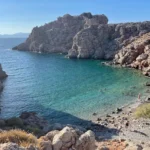
- 12.1 km
- Pahia Ammos beach
- Pebbles, Sand
- Normal
- Blue
Pachia Ammos is a large village situated on the north side of the narrowest part of Crete, 20km east of Agios Nikolaos, on the road connecting Agios Nikolaos with Sitia and Ierapetra. The village is located at the exit of a fertile plain that is covered with olive groves. It has experienced mild development due to its local beach and the sights of the surrounding area. Visitors can find small hotels, rooms, and taverns in the village.
A long beach with sand and pebbles stretches in front of Pahia Ammos, 500m to the east. The beach is open to the north winds, and the sea is usually wavy. However, visitors can stay safe in the well-protected west part of the beach, which is sandy and clean and has umbrellas and sunbeds. For those seeking peace, the eastern part of the beach is an option, but it is unprotected from the waves, and currents carrying garbage due to the village’s location in the southern part of the Gulf of Mirabello. The beach in this area is pebbly and has several tamarisk trees. At the east end of the beach, a stream flows from the impressive Gorge of Ha in winter.
Pahia Ammos is situated on the site of the ancient city Minoa, which was an old harbour. The Institute for the Study of Prehistoric Aegean of East Crete is established here, which conducts systematic excavations in the area and deals with the promotion and protection of antiquities. The most famous archaeological site in the region is the Minoan cemetery and the settlement of Gournia, which is located 2km west of the village. The city flourished in 1600 BC and was built on a small hill. Gournia is located 2km east of Faneromeni Monastery, one of the most impressive monasteries in Crete built on a steep cliff.
Visitors can also visit the Minoan settlement Vasiliki, which is 4km south of the village and flourished in 2600-2300 BC. Vasiliki is considered the precursor of the major Minoan palaces and towns. From Vasiliki, visitors can drive 2km to the east to reach the village of Monastiraki, with the old watermills and the church of St. Stephen. Nearby is the exit of the imposing gorge of Ha, which causes awe from miles away.
Opposite Pahia Ammos you’ll see the small island Konida (i.e. nit, the egg of louse), which can be reached by boat. It is interesting to see how the place’s name has emerged; a few miles to the east (opposite Tholos) you’ll meet the very important island Psira (i.e. louse), while opposite Mochlos you’ll see the islet of Agios Nikolaos, also called Psilos (flea). All bugs together!

- 12.4 km
- Charkomatas beach
- Pebbles
- Deep
- Deep blue
It’s definitely worth your while to venture west from the Papadiokambos settlement, particularly on those seldom windless days. You might consider parking your car roadside, bypassing the wire fence, and taking a brief 2-minute stroll to the mouth of the gorge that stretches from the Liopetro region to the stunning Charkomatas beach, located near Roussa Limni. The breathtaking formations of the Charkomatas gorge, carved from layers of limestone, are sure to leave a lasting impression.
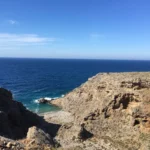
No results available
ResetBeaches in other nearby areas
No results available
Reset